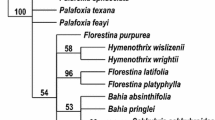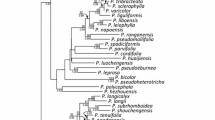Abstract
Ten species of Polygala closely related to P. major are recorded in Southwest Asia. Most of them were described as local endemics of the Transcaucasia. However, species of the P. major complex are often difficult to identify, having rather subtle and changeable morphological features that could not be treated as essential. The phylogenetic analysis of sequences of the nrITS/ETS and chloroplast trnL–trnF regions (intron and spacer) showed their extreme similarity. Based on the molecular evidence and main diagnostic morphological features, the ten species of the P. major complex are synonymized under P. major. Typifications of eight combinations in Polygala from Western Asia and Europe are also clarified.



Similar content being viewed by others
References
Abbott JR (2011) Notes on the disintegration of Polygala (Polygalaceae), with four new genera for the flora of North America. J Bot Res Inst Texas 5:125–137
Baldwin BG, Markos S (1998) Phylogenetic utility of the external transcribed spacer (ETS) of 18s–26s rDNA: congruence of ETS and ITS trees of Calycadenia (Compositae). Molec Phylogen Evol 10:449–463. https://doi.org/10.1006/mpev.1998.0545
Bena G, Jubier MF, Olivieri I, Lejeune B (1998) Ribosomal external and internal transcribed spacers: combined use in the phylogenetic analysis of Medicago (Leguminosae). J Molec Evol 46:299–306. https://doi.org/10.1007/PL00006306
Bernardi LF (2000) Consideraciones taxonómicas y fitogeográficas acerca de 101 Polygalae Americanas. Cavanillesia Altera 1. Real Jardín Botánico, Madrid
Boissier PE (1854) Diagnoses plantarum novarum præsertim orientalium nonnullis Europæis boreali-Africanisque additis. Series secunda 1, Typis Henrici Wolfrath, Necomi
Chodat R (1893) Monographia Polygalacearum. II. Mém Soc Phys Genève 31:1–500
Cronquist A (1981) An integrated system of classification of flowering plants. Columbia University Press, New York
Cullen J (1965) Polygala L. In: Davis PH (ed) Flora of Turkey and the East Aegean Islands, vol 1. Edinburgh University Press, Edinburgh, pp 533–539
Dönmez AA, Aydin ZU, Işik S (2015) Polygala turcica (Polygalaceae), a new species from E Turkey, and a new identification key to Turkish Polygala. Willdenowia 45:429–434. https://doi.org/10.3372/wi.45.45309
Edgar RC (2004) MUSCLE: multiple sequence alignment with high accuracy and high throughput. Nucl Acids Res 32:1792–1797. https://doi.org/10.1093/nar/gkh340
Erixon P, Svennblad B, Britton T, Oxelman B, Sullivan J (2003) Reliability of Bayesian posterior probabilities and bootstrap frequencies in Phylogenetics. Syst Biol 52:665–673
Euro + Med (2018) The information resource for Euro-Mediterranean plant diversity. Available at: http://emplantbase.org. Accessed 25 Dec 2018
Felsenstein J (1985) Confidence limits on phylogenetics: an approach using the bootstrap. Evolution 39:783–791. https://doi.org/10.1111/j.1558-5646.1985.tb00420.x
Forest F, Nänni I, Chase MW, Crane PR, Hawkins JA (2007) Diversification of a large genus in a continental biodiversity hotspot: temporal and spatial origin of Muraltia (Polygalaceae) in the Cape of South Africa. Molec Phylogen Evol 43:60–74. https://doi.org/10.1016/j.ympev.2006.08.017
Grossheim AA (1950) Plantarum species novae et criticae e Caucaso. Bot Mater Gerb Bot Inst Komarova Akad Nauk SSSR 13:3–31 (in Russian)
Hall TA (1999) BioEdit: a user-friendly biological sequence alignment editor and analysis program for Windows 95/98/NT. Nucl Acids Symp Ser 41:95–98
Jalilian N (2005) Flora of Iran 49: Polygalaceae. Research Institute of Forests and Rangelands Publication, Teheran (in Persian)
Kemularia-Nathadze LM (1948) Addenda nova ad cognitionen generis Polygalae L. Zametki Sist Geogr Rast 14:24–35 (in Russian)
Kemularia-Nathadze LM, Davlianidze MT (1983) Polygalaceae. In: Ketskhoveli NN (ed) Flora of Georgia, vol. 8. Mezniereba, Tbilisi, pp 121–135 (in Georgian)
Kerrigan RA (2012) A treatment for Polygala of northern Australia. Austral Syst Bot 25:83–137. https://doi.org/10.1071/SB08032
Logacheva MD, Valiejo-Roman CM, Degtjareva GV, Stratton JM, Downie SR, Samigullin TH, Pimenov MG (2010) A comparison of nrDNA ITS and ETS loci for phylogenetic inference in the Umbelliferae: an example from tribe Tordylieae. Molec Phylogen Evol 57:471–476. https://doi.org/10.1016/j.ympev.2010.06.001
Lyskov DF, Degtjareva GV, Samigullin TH, Pimenov MG (2017) The revision of Prangos subsections Koelzella and Fedtschenkoana (Apiaceae) with some notes to phylogeny and biogeography of the genus: molecular and morphological evidences. Pl Syst Evol 303:815–826. https://doi.org/10.1007/s00606-017-1412-0
Markos S, Baldwin BG (2001) Structure, molecular evolution, and phylogenetic utility of the 5’ region of the external transcribed spacer (ETS) of 18s–26s rDNA in Lessingia (Compositae, Astereae). Molec Phylogen Evol 23:214–228. https://doi.org/10.1016/S1055-7903(02)00004-0
McNeill J (1968a) Polygala L. In: Tutin TG et al (eds) Flora Europae, vol. 2. University Press, Cambridge, pp 231–236
McNeill J (1968b) Taxonomic and Nomenclatural Notes on Polygala in Europe In: Heywood VH (ed.) Notulae Systematicae ad Floram Europaeam spectantes. Feddes Repert 79:23–34
Nevski SA, Tamamschjan SG (1949) Polygalaceae. In: Schischkin BK, Bobrov EG (eds) Flora of URSS 14. Edito Academiae Scientiarum URSS, Moscow, pp 246–266 (in Russian)
Nylander JAA (2004) MrModeltest v2.3. Program distributed by the author. Evolutionary Biology Centre, Uppsala University, Uppsala
Page RDM (1996) TREEVIEW: an application to display phylogenetic trees on personal computers. Computer Appl Biosci 12:357–358. https://doi.org/10.1093/bioinformatics/12.4.357
Paiva JAR (1998) Polygalarum Africanarum et Madagascariensium prodromus atque gerontogaei generis Heterosamara Kuntze, a genere Polygala L. segregati et a nobis denuo recepti, synopsis monographica. Fontqueria 50:1–346
Pastore JFB (2018) Polygala veadeiroensis (Polygalaceae), a new species of Polygala endemic to Chapada dos Veadeiros, Goiás, Brazil. Kew Bull 73:37. https://doi.org/10.1007/s12225-018-9759-0
Pastore JFB, Abbott JR, Neubig KM, Whitten WM, Mascarenhas RB, Mota MCA, van den Berg C (2017) A molecular phylogeny and taxonomic notes in Caamembeca (Polygalaceae). Syst Bot 42:54–62. https://doi.org/10.1600/036364417X694935
Ronquist F, Teslenko M, van der Mark P, Ayres DL, Darling A, Höhna S, Larget B, Liu L, Suchard MA, Huelsenbeck JP (2012) MrBayes 3.2: efficient Bayesian phylogenetic inference and model choice across a large model space. Syst Biol 61:539–542. https://doi.org/10.1093/sysbio/sys029
Starr JR, Harris SA, Simpson DA (2003) Potential of the 5′ and 3′ ends of the intergenic spacer (IGS) of rDNA in the Cyperaceae: new sequences for lower-level phylogenies in sedges with an example from Uncinia Pers. Int J Pl Sci 164:213–227. https://doi.org/10.1086/346168
Sun Y, Skinner DZ, Liang GH, Hulbert SH (1994) Phylogenetic analysis of Sorghum and related taxa using internal transcribed spacers of nuclear ribosomal DNA. Theor Appl Genet 89:26–32. https://doi.org/10.1007/BF00226978
Swofford DL (2003) PAUP*. Phylogenetic analysis using parsimony (*and other methods): Version 4. Sinauer Associates, Sunderland
Taberlet P, Gielly L, Pautou G, Bouvet J (1991) Universal primers for amplification of three non-coding regions of chloroplast DNA. Pl Molec Biol 17:1105–1109. https://doi.org/10.1007/BF00037152
Tamamschjan SG (1936) Über einige Polygalaceen aus dem Kaukasus. Repert Spec Nov Regni Veg 39:321–329
Telitsyna IV, Galkin MA, Shvanova VV, Yeliseyeva LM, Bezrodnova EI (2018) Comparative research of the anatomical structure of the stem of the North Caucasian species Polygala anatolica, Polygala albowii. In: Budancev AL (ed) Botanika v sovremennom mire: Trudy s’yezda russkogo botanicheskogo obshchestva i konferentsii. ALEF, Makhachkala, pp 209–210 (in Russian)
Thiers B (2018) Index Herbariorum: a global directory of public herbaria and associated staff. Available at: http://sweetgum.nybg.org/ih. Accessed 25 Dec 2018
Turland NJ, Wiersema JH, Barrie FR, Greuter W, Hawksworth DL, Herendeen PS, Knapp S, Kusber W-H, Li D-Z, Marhold K, May TW, McNeill J, Monro AM, Prado J, Price MJ, Smith GF (eds) (2018) International code of nomenclature for algae, fungi, and plants (Shenzhen Code). Regnum Vegetabile 159. Koeltz Botanical Books, Glashütten. Available at: https://doi.org/10.12705/Code.2018
Acknowledgements
We thank curators and staff of the herbaria for providing material for our study; Laurence Loze and Laurent Gautier for their help with obtaining images of the original material for Polygala anatolica; and Alexey Seregin and Galina Degtjareva for helpful comments. The study was supported by the International Association for Plant Taxonomy Research Grants Program in Plant Systematics. JFBP gratefully acknowledges funding for a research fellowship (302452/2017-6) from the CNPq (Conselho Nacional de Desenvolvimento Científico e Tecnológico). The authors are grateful to Pyotr Petrov and Alex Popovkin for editing the English version of the manuscript.
Author information
Authors and Affiliations
Corresponding author
Ethics declarations
Conflict of interest
The authors declare that they have no conflict of interest.
Additional information
Publisher's Note
Springer Nature remains neutral with regard to jurisdictional claims in published maps and institutional affiliations.
Electronic supplementary material
Below is the link to the electronic supplementary material.
Information on Electronic Supplementary Material
Information on Electronic Supplementary Material
Online Resource 1. Genetic distances within the Polygala major complex.
Online Resource 2. Bayesian phylogenetic tree based on the trnL–trnF sequence analysis, with posterior probability values and bootstrap values of maximum parsimony shown.
Online Resource 3. Lectotype of Polygala major (W0058270). Photograph courtesy of the Naturhistorisches Museum Wien.
Online Resource 4. Lectotype of Polygala anatolica (G00418870). Photograph courtesy of the Conservatoire et Jardin botaniques dela Ville de Genève.
Rights and permissions
About this article
Cite this article
Lyskov, D., Pastore, J.F.B. & Samigullin, T. One for all: molecular study of Polygala major complex (Polygalaceae) in Southwest Asia. Plant Syst Evol 305, 975–984 (2019). https://doi.org/10.1007/s00606-019-01618-x
Received:
Accepted:
Published:
Issue Date:
DOI: https://doi.org/10.1007/s00606-019-01618-x




